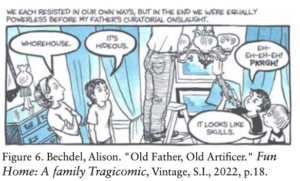Analyzing Empathy in Graphic Memoirs: Persepolis and Fun Home by Zachary Inzlicht
In the graphic memoirs Persepolis by Marjane Satrapi and Fun Home by Alison Bechdel, the unique medium serves as a powerful tool for navigating complex emotions related to the themes of family dynamics and personal identity. To explore these themes, Satrapi and Bechdel employ family portraits, first-person narration, and violent imagery to highlight the empathetic potential inherent in the graphic memoir form.
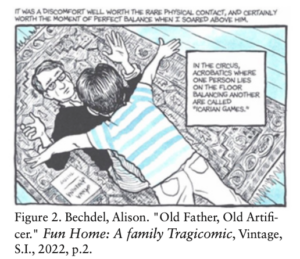
In Persepolis and Fun Home, Marjane Satrapi and Alison Bechdel’s portraiture within panels illustrate family dynamics. Specifically, both authors use facial expressions and body language to highlight this theme. In fig. 1, there are contrasting emotions seen on the faces of Marjane and her parents. Marjane’s angry facial expression reflects her frustration and eagerness to participate in the Iranian Revolution. The tension in the family dynamic is further highlighted by her parents’ sad expressions, which indicate their concern for her safety. Additionally, the positioning of the characters adds depth to the portrait. The parents facing in different directions, while both looking up, suggests a shared sense of concern for the future. The black background further emphasizes the seriousness of the situation, creating a visual contrast that enhances the emotional impact of the scene. All these elements piece together, to show a closer look at the complex family dynamics in this graphic memoir. In fig. 2, the father’s body language that contrasts with his facial expression indicates an unwilling participation in the game he is playing with his daughter. Although his arms are open to catch her, his face remains neutral. Contrarily, Bechdel’s arms are outstretched, and her face is hidden. This contrast indicates that while Bechdel seeks connection and playfulness, her father is emotionally distant. The daughter’s obscured face can symbolize the challenges that she has connecting emotionally with her father. Through body language and facial expression, this specific portrait implies that there is a dysfunctional family dynamic in Bechdel’s household. The portrayal of emotions through body language and facial expressions in both memoirs reveal complex family dynamics. Thus, these graphic memoirs have strong empathic potential that highlight the themes mentioned within the texts.
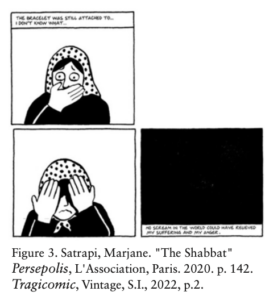 Not only do Persepolis and Fun Home both recount family narratives, they also have first person narration to provide a deeper, emotional exploration of family dynamics and personal identity. In Persepolis, the narration is very informal, mimicking a stream of consciousness. This style creates a strong connection between the readers and the character narrating by placing the reader in the narrator’s perspective, allowing them to share her emotions. This is evident in fig. 3, especially in the last frame, where the narration states, “no scream in the world could have relieved my suffering and my anger.” Rather than selecting a straightforward description, the author deliberately chooses emotional language. The absence of visuals in this panel directs focus to the narration, encouraging readers to visualize the scene independently. All the panels in fig. 3 come together to form a deep exploration of Marjane’s personal identity, revealing a potential source for Marjane’s strong desire to participate in the revolu- tion. As a result she is surrounded by the constant presence of death and the revolution’s repercussions, and she feels compelled to become a rebel and protest. Through the emotional first-person narrative style, the author depicts the personal identities of the characters within her graphic memoir. In Fun Home, the narration is graver and more serious, contrasting the seemingly mundane
Not only do Persepolis and Fun Home both recount family narratives, they also have first person narration to provide a deeper, emotional exploration of family dynamics and personal identity. In Persepolis, the narration is very informal, mimicking a stream of consciousness. This style creates a strong connection between the readers and the character narrating by placing the reader in the narrator’s perspective, allowing them to share her emotions. This is evident in fig. 3, especially in the last frame, where the narration states, “no scream in the world could have relieved my suffering and my anger.” Rather than selecting a straightforward description, the author deliberately chooses emotional language. The absence of visuals in this panel directs focus to the narration, encouraging readers to visualize the scene independently. All the panels in fig. 3 come together to form a deep exploration of Marjane’s personal identity, revealing a potential source for Marjane’s strong desire to participate in the revolu- tion. As a result she is surrounded by the constant presence of death and the revolution’s repercussions, and she feels compelled to become a rebel and protest. Through the emotional first-person narrative style, the author depicts the personal identities of the characters within her graphic memoir. In Fun Home, the narration is graver and more serious, contrasting the seemingly mundane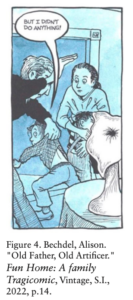 scenes pictured within. The narration, while in first person, often uses hyperboles to shed light on the prevailing theme of dysfunctional family dynamics. This is apparent in fig. 4 where the narrator mentions being “powerless before [her] father’s curatorial onslaught.” This strong emotion evoked by the hyperbolic narration contrasts the prosaic nature of the scene, indicating that while on the surface the family dynamics may seem healthy, it is anything but. The narrator clearly displays the father as being emotionally distant, eager for control and indifferent towards his family’s opinions. The narrative style used by Bechdel allows her to present dysfunctional family dynamics without detracting from the story. The empathic potential of the graphic memoir medium and first-person narrative techniques evoke emotional responses, thus allowing for a deeper exploration of the themes of personal identity and family dynamics.
scenes pictured within. The narration, while in first person, often uses hyperboles to shed light on the prevailing theme of dysfunctional family dynamics. This is apparent in fig. 4 where the narrator mentions being “powerless before [her] father’s curatorial onslaught.” This strong emotion evoked by the hyperbolic narration contrasts the prosaic nature of the scene, indicating that while on the surface the family dynamics may seem healthy, it is anything but. The narrator clearly displays the father as being emotionally distant, eager for control and indifferent towards his family’s opinions. The narrative style used by Bechdel allows her to present dysfunctional family dynamics without detracting from the story. The empathic potential of the graphic memoir medium and first-person narrative techniques evoke emotional responses, thus allowing for a deeper exploration of the themes of personal identity and family dynamics.
Persepolis and Fun Home surpass the traditional memoir format by harnessing violent graphics that can only be properly displayed in the visual medium. Both graphic memoirs feature these suggestive images to provide an emotional and sensory experience for the readers, consequently bringing forth themes of family and identity. In Persepolis, violent graphics not only capture the harsh realities of the Iranian revolution but are also vital in representing Marjane’s struggle to define her own identity during a revolution. This is seen clearly in fig. 5,
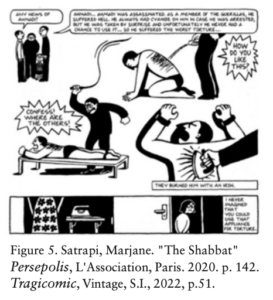
as the second panel shows Marjane’s gaze fixed on her household iron. In the previous panel, Marjane and the readers were subjected to a detailed recount of a torture scene involving an iron. Consequently, the iron takes on a symbolic significance, it becomes a potential instrument of torture, a reminder of the constant threat and danger that infiltrated even the most normal aspects of Marjane’s existence. The duality of this symbol highlights the empathetic potential of this medium as the readers are made to empathize with Marjane’s internal turmoil. Thus, through violent graphics, Satrapi accurately conveys the theme of personal identity found within her memoir. In Fun Home, Bechdel uses violent graphics to poignantly represent dysfunctional family dynamics. In fig. 6, Bechdel’s plea, “but I didn’t do anything,” depicts the vulnerability and injustice of the moment, triggering empathy from the reader.
The mother’s protective stance, clutching her other child who appears to be crying, adds another layer of emotional complexity. This scene highlights how graphics portraying violence within a familial context can leverage the empathetic potential of the medium. By showing the tension, fear, and anger within the family, Bechdel perfectly illustrates the family dynamic present in her memoir. The emotions conjured by the violent graphics present in both memoirs reveal the empathic potential of the medium. Since the graphics evoke such emotions in the readers, the authors are able to better intimate the themes of family dynamics and personal identity.
In conclusion, both Persepolis and Fun Home employ a unique visual medium to express the complex themes of personal identity and family dynamics. Through family portraiture, first-person narration, and violent imagery, Marjane Satrapi and Alison Bechdel evoke emotional responses, thus proving the empathetic potential of the graphic memoir medium to explore various themes.
Works Cited
Bechdel, Alison. Fun Home: A Family Tragicomic. Vintage, 2022.
Satrapi, Marjane. Persepolis. L’Association, 2020.
